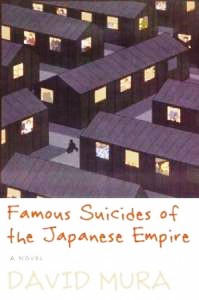âÄúFamous Suicides of the Japanese EmpireâÄù Author: David Mura Publisher: Coffee House Press Pages: 265 Price: $14.95 The novel is a distinct breed of book. It affords an author the opportunity to experiment with structure and story, to give life to peculiar characters, to illuminate cultural quirks and to lie a bit about whatever he or she chooses. David MuraâÄôs first fiction book, âÄúFamous Suicides of the Japanese Empire,âÄù is solidly written on a sentence-by-sentence basis, but as a whole, the reality of his imagined world can be tersely summed into one blunt reflex of the mouth: Yawwwwwn. This is fiction âÄî why doesnâÄôt the author take some chances? Narrator Ben Ohura is a grown man. As a struggling historian and teacher, he understands people in terms of their origin and their experiences. So it is no surprise that Ohura deals with his familyâÄôs chaotic past with a thorough, sometimes seemingly inconsequential, examination of his familyâÄôs history. Because BenâÄôs parents were Japanese-Americans during World War WII, they were detained in internment camps. BenâÄôs father was also a member of the No-No Boys, a group of draft resisters. These realities come to alter BenâÄôs perception of himself as a Japanese-American. BenâÄôs brother, though widely thought of as a genius, experienced his equal share of growing pains, some of them likely the result of his rocky fraternal relations. Eventually, he goes missing. After the death of the boysâÄô mother, a years-old letter mysteriously arrives from BenâÄôs long-missing brother. ItâÄôs from this point that the Ohura history is rehashed and reflected upon. In the past, David Mura has released works of creative nonfiction and poetry. Maybe understandably, the pages of this fiction book are filled with a tone that feels unlike many fiction books. The narrator muses and meanders through the familyâÄôs history the way many memoir writers do; previously unknown truths are unveiled, family drama is exposed for all to see, and reflections and realizations take place âÄî and the real story, the heart of the work, is pondered. But for a fiction book, Mura presents conflict haphazardly. Instead of a careful dramatic escalation, the focus is placed on the forged emotional weight of every situation. Worsening things is the character development. The narrator and his brother tend to feel a bit on the flat, unreal side of things. Especially unconvincing are adult BenâÄôs ideas of who he was as a child. The picture of a heart-aching family is fondly created, but the narrative execution lacks a certain vigor needed to compel the reader. Without it, there is no empathy for the story or its characters, and because of that, the reader is prone to setting down the book unfinished. The story is punctuated with illusions and all-out references to suicide. As a third-generation Japanese-American, BenâÄôs ideas about suicide are speckled with the reality of the self-destructive Japanese attacks on Pearl Harbor and other cultural artifacts that may mix the idea of suicide with the concept of pride. The book thrives most when itâÄôs dealing with issues of identity and difference such as this. Especially poignant are the underlying differences among members of the Ohura family. Many readers will identify with the angsty family interactions, even though these relations arenâÄôt remarkably inventive. As a whole, the work lacks the original verve needed to execute this sad history. At times, one unimportant emotional conflict follows another âÄî and it shouldnâÄôt be the readersâÄô fault if they feel disconnected or separated from the charactersâÄô emotions. Instead of creating a portrait of sadness, the novel feels explicit. Unfortunately, itâÄôs hard to get people to feel for your characters when youâÄôve given them little reason to believe in their mortality.











